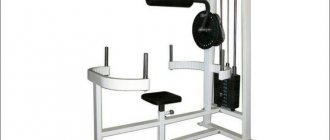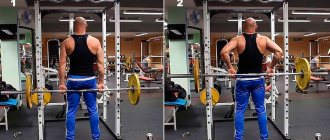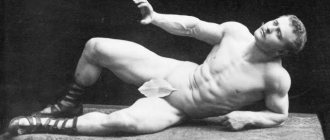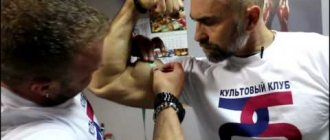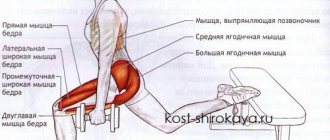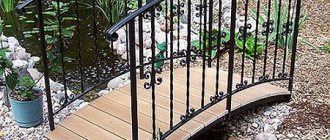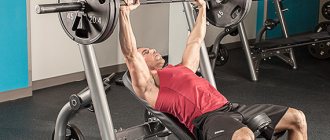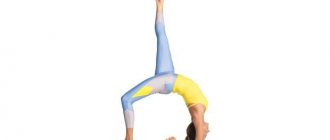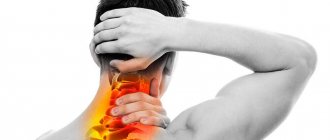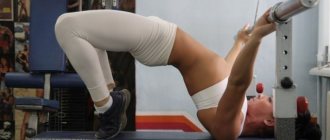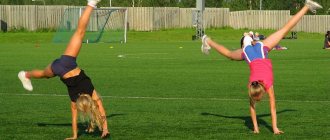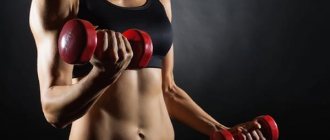RACKS
Stand is a static vertical position in which the student is upside down.
Fixing the stand for 2–3 seconds. BLADE STAND
with different positions of the legs with and without support under the back
HEADSTAND AND HANDSTAND
(legs apart, legs apart shin inward, split, half-split).
FORUM STAND
with different positions of the legs: legs bent, legs crossed, right leg bent forward, left leg bent back.
HANDSTAND
with different leg positions and in a rotation of 180°-1080°.
STAND WITH DEFLECTION “MEXICAN”
on the forearms, on the hands.
HANDSTAND “FLAG”
– stand on one arm, legs lowered to the side to a horizontal position, free hand to the side.
Variations of the gluteal bridge
There are several options for performing the gluteal bridge, which allows you to diversify the training process, increase the complexity of the implementation, and not get tired of constantly repeating the same “bridge.”
Those who are shy or think that they will be looked at askance can do it at home, as long as they do not have to use additional weights. This is especially true for men.
Bodyweight glute bridge
To do a glute bridge, you need to lie with your back on the floor, put your arms at your sides, and bend your knees so that both feet, shoulder-width apart, are firmly on the floor. The back should be in a neutral position.
Raising the pelvis is carried out with the entire emphasis placed on the heels. When lifting, you need to rest your heels as much as possible on the floor surface and squeeze your buttocks. You can stop while moving upward only after a bridge has formed, when the body from the knees to the shoulders does not form one line. You should stay at this point for a couple of seconds, continuing to squeeze your buttocks.
You must descend slowly and carefully. When planning to do another approach, you cannot relax your muscles. To achieve a truly significant effect in a shorter period of time, make sure that the amplitude of the movement remains the same and does not decrease with each new approach. In total, you need to try to make at least three “bridges”, giving all your best to failure.
Glute bridge with barbell
You can lift the barbell not only from the chest, but also by lifting the pelvis. Of course, such a performance requires appropriate preparation, since the maximum load is taken. Women involved in bodybuilding are recommended to take 113, and men - up to 182 kilograms. Such heaviness instantly deprives the gluteal bridge of its “for the weak” status.
If the level of training does not allow lifting such a weight, and the weights are less than 60 kilograms, then the barbell is used with an Olympic bar. It has a wide girth, but weighs 10 or 15 kilograms. Olympic-style discs require a high lift. Otherwise, it will be difficult to place the barbell comfortably on your hips.
The projectile must be placed closer to the perineal area. A pad or towel, which is used when doing squats with a barbell and other similar exercises, can help relieve excess tension. Thanks to this, there will be no marks left on the skin. Both shoulders and shoulder blades should be pressed against the bench, with emphasis placed on the heels when lifting.
Correct execution is indicated by the placement of the knee joints, hips and shoulder girdle on the same straight line. As with a regular bridge, at the top point they linger for two seconds, keeping the gluteal muscles squeezed. While lowering the bar, make sure it does not touch the floor until the second repetition begins. In total, it is recommended to do at least 3 approaches with 10-12 pelvic lifts in each.
Glute bridge with one leg raise
It is performed with a shock absorber or barbell, and without weighting. If a barbell is used, the apparatus is lightened.
To take the starting position, lie on the floor, bend your knees, and rest your feet on the floor. The leg is raised up, the knee is pushed closer to the chest.
They make a bridge by pushing off the floor, while the toe may come off. The thigh should stretch and the pelvis should rise. When lowering, you need to completely relax, and only then do the repetition.
If some aspects of the execution technique are not entirely clear, it is better to watch the video and only then start performing it. A visual aid will allow you to do the gluteal bridge without mistakes.
There is another variation of this exercise called the reverse glute bridge, performed on an elevated platform. It requires the use of a bench or other support. A shock absorber can be used here.
Take the starting position, but only the feet are placed on the bench, and the pelvis is close to the hill. As they rise, they move closer to the bench, and raise their right leg diagonally.
All emphasis is placed on the left heel. The right leg should be raised so that a diagonal line passes through the thigh, that is, from the ankle to the shoulder. Hold the top point for a couple of seconds, when lowering, do not touch the floor, but immediately do a repetition, the number of which should be maximum.
To achieve balanced development, the glute bridge must be an integral part of the training process. It, like squats, must be done in various variations.
Variety can be achieved by periodically lifting heavy weights or increasing the number of repetitions, as well as using shock absorbers. The variability of the exercise allows you not to get tired of the same monotonous performance of the gluteal bridge, resulting in beautiful and strong buttocks.
BRIDGES
Bridge - an arched, maximally bent position of the practitioner, supporting himself on his legs and arms with his back down. How to do it:
Bending from a supine position with support on bent legs and arms;
TILT BACK from the stance, legs apart, arms up;
TURN 180° from a crouching position;
BENDING through a handstand;
EXTENSION from emphasis lying on the shoulder blades.
KNEELING STAND BRIDGE
– bridge with support on the legs and arms;
BRIDGE IN TOE STAND
FOREARM BRIDGE – a bridge supported by the legs and forearms;
ONE LEG BRIDGE
bridge supported by arms and legs (free leg forward or bent forward);
ONE-ARM BRIDGE
– a bridge supported by legs and one arm;
BRIDGE WITH A RING
– the same, but the free leg is bent back and close to the head;
BRIDGE WITH TWINE
– the same, but the free leg is raised to a vertical position and forms a straight line with the supporting leg;
BRIDGE WITH CAPTURE (BRIDGE “SKLAAKA”)
– bridge on the legs with hands grabbing the shins;
BRIDGE WITH THE SAME SUPPORT
– a bridge supported by the right (left) arm and leg;
BRIDGE WITH DIFFERENT SUPPORT
- the same, but on the right leg and left arm (or vice versa).
Cerebellum (small brain), cerebellum,
located posterior (dorsal) from the pons and from the upper (dorsal) part of the medulla oblongata.
It lies in the posterior cranial fossa. Above the cerebellum hang the occipital lobes of the cerebral hemispheres, which are separated from the cerebellum by the transverse fissure of the cerebrum, fissura transverse, cerebrdlis.
In the cerebellum, there are superior and inferior surfaces , the boundary between which is the posterior edge of the cerebellum, where a deep horizontal fissure, fissurahorizontalis, passes.
It begins at the point where its middle peduncles enter the cerebellum.
On the lower surface there is the cerebellar valley, valleculacerebelli;
The dorsal surface of the medulla oblongata is adjacent to this depression.
In the cerebellum, there are two hemispheres, hemispheriacerebelli (neocerebellum,
except for the flocculus), and an unpaired median part -
the cerebellar vermis, vermiscerebelli
(phylogenetically
old part).
The upper and lower surfaces of the hemispheres and the vermis are cut by many
fissures of the cerebellum, fissuracerebelli,
between which there are long and narrow
leaves
(gyri)
of the cerebellum, foliacerebelli.
Groups of gyri, separated by deeper grooves, form
the cerebellar lobules, lobulicerebelli.
Each lobe of the worm corresponds to two (right and left) lobes of the hemispheres.
The more isolated and phylogenetically older lobule of each hemisphere is the flocculus.
It is adjacent to the ventral surface of the middle cerebellar peduncle.
With the help of the long leg of the flocculus, pedunculus flocculi,
the flocculus is connected to the cerebellar vermis, with its
node, nodulus.
The cerebellum is connected to neighboring parts of the brain by three pairs of peduncles . Inferior cerebellar peduncles (rope bodies), pedunculicerebellarescaudales,
connect the cerebellum to the medulla oblongata.
The middle cerebellar peduncles, pedunculicerebellaresmedii,
pass into the pons.
The superior cerebellar peduncles, pedunculicerebellarescraniales,
connect the cerebellum to the midbrain. The cerebellar peduncles contain fibers of the pathways that connect the cerebellum with other parts of the brain and the spinal cord.
The cerebellar hemispheres and the vermis consist of the medullary body, corpus medullare,
white matter and a thin layer of gray matter covering the periphery of the white matter,
The white matter of the cerebellum contains paired cerebellar nuclei, nucleicerebelli
.
These are: dentate nucleus, nucleusdentdtus
;
corky nucleus, nucleusemboliformis;
spherical nucleus,
nucleus globosus;
tent core,
nucleus fastigii.
In the dorsal sections of the bridge, ascending sensory pathways follow, and in the ventral sections, descending pyramidal and extrapyramidal pathways follow.
Bridge
Bridge, pons
(pons), borders the midbrain (with the cerebral peduncles), and below (back) - with the medulla oblongata.
The dorsal surface of the bridge faces the fourth ventricle and participates in the formation of its bottom rhomboid fossa. In the lateral direction, the bridge passes into the middle cerebellar peduncle, pedunculuscere-belldrismedius
. The border between the middle cerebellar peduncle and the pons is the exit point of the trigeminal nerve. In the deep transverse groove separating the pons from the pyramids of the medulla oblongata, the roots of the right and left abducens nerves emerge. In the lateral part of this groove the roots of the facial (VII pair) and vestibulocochlear (VIII pair) nerves are visible.
On the ventral surface of the bridge, which in the cranial cavity is adjacent to the clivus,
the basilar (main) groove, sulcus basilaris,
is noticeable The artery of the same name lies in this groove.
In the central sections of the bridge section, a thick ray of fibers is noticeable, which belongs to the conduction path of the auditory analyzer - the trapezoidal body, corpustrapezoideum.
This formation divides the bridge into a posterior part, or bridge cover,
parsdorsalis,
and an anterior (basilar) part,
parsventralis.
Between the fibers of the trapezoid body are
the anterior and
posterior
In the anterior (basilar) part of the bridge (at the base), longitudinal and transverse fibers are visible.
The longitudinal fibers of the bridge, libraepontis longitudindles,
belong to the pyramidal tract
(cortical-nuclear fibers, fibraecorticonucleares).
There are also
cortico-pontine fibers, fibraecorticopontinae,
which end on
the nuclei
(proper)
of the bridge, nucleipontis
.
The processes of the nerve cells of the pons nuclei form bundles of transverse fibers of the bridge, fibraepontis transversae.
The latter form the middle cerebellar peduncles.
In the posterior (dorsal) part (pons tegmentum) there are accumulations of gray matter - the nuclei, V, VI, VII, VIII pairs of cranial nerves. of the medial lemniscus, lemniscus medlis, lie above the trapezoid body
and lateral to them -
the spinal loop, lemniscus spinalis.
Above the trapezoidal body is the reticular formation, and even higher is
the posterior longitudinal fasciculus, fasciculus longitundlisdorsdlis.
Lateral and above the medial lemniscus lie the fibers of the lateral lemniscus.
The midbrain, mesencephalon, is less complex. It has a roof and legs. The cavity of the midbrain is the cerebral aqueduct. The upper (anterior) border of the midbrain on its ventral surface is the optic tracts and mammillary bodies, and on the posterior surface is the anterior edge of the pons. On the dorsal surface, the upper (anterior) border of the midbrain corresponds to the posterior edges (surfaces) of the thalamus, the posterior (lower) border corresponds to the level of exit of the trochlear nerve roots.
Roof of the midbrain, tectummesencephalicum,
located above the cerebral aqueduct.
The roof of the midbrain consists of four elevations - mounds. The latter are separated from each other by grooves. The longitudinal groove is located to form a bed for the pineal gland. A transverse groove separates the superior colliculi, colliculisuperiores,
from the inferior colliculi,
colliculiinferiores.
From each of the mounds, thickenings in the form of a roller extend in the lateral direction - the handle of the mound. The superior colliculus of the midbrain roof (quadrigeminal) and the lateral geniculate body perform the function of subcortical visual centers. The inferior colliculus and medial geniculate body are subcortical auditory centers.
peduncles of the brain, pedunculicerebri,
coming out of the bridge.
The depression between the right and left cerebral peduncles is called the interpeduncular fossa, fossa interpeduncularis.
The bottom of this fossa serves as a place where blood vessels penetrate the brain tissue.
On the medial surface of each of the cerebral peduncles there is a longitudinal oculomotor groove, sulcusoculomotorus
(medial groove of the cerebral peduncle), from which
the roots of the oculomotor nerve, n. oculomotorius
(III pair), emerge.
The cerebral peduncle secretes the black substance, substantianigra
.
The substantia nigra divides the cerebral peduncle into two sections: the posterior (dorsal) - tegmentum of the midbrain, tegmentummesencephali,
and the anterior (ventral) section - the base of the cerebral peduncle,
basispedunculicerebri.
The midbrain nuclei lie in the tegmentum and ascending pathways pass through. The base of the cerebral peduncle consists entirely of white matter; descending pathways pass here.
Aqueduct of the midbrain (Aqueduct of Sylvius), aqueductus mesencephali (cerebri),
connects the cavity of the third ventricle with the fourth and contains cerebrospinal fluid. In its origin, the cerebral aqueduct is a derivative of the cavity of the middle cerebral bladder.
Around the midbrain aqueduct is the central gray matter, substantiagriseacentrdlis,
in which, in the area of the bottom of the aqueduct, there are nuclei of two pairs of cranial nerves.
At the level of the superior colliculi there is a paired nucleus of the oculomotor nerve, nucleus nervioculomotorii.
It takes part in the innervation of the eye muscles.
More ventrally, the parasympathetic nucleus of the autonomic nervous system is localized - the accessory nucleus of the oculomotor nerve,
nucleusoculo
.
Anterior and slightly above the nucleus of the third pair is the intermediate nucleus, nucleus interstitialis.
The processes of the cells of this nucleus participate in the formation of the reticulospinal tract and the posterior longitudinal fasciculus.
At the level of the inferior colliculi in the ventral sections of the central gray matter lies the nucleus of the trochlear nerve, nucleus. trochlearis.
In the lateral parts of the central gray matter throughout the entire midbrain there is the nucleus of the midbrain tract of the trigeminal nerve (V pair).
In the tegmentum, the largest and most noticeable on a cross section of the midbrain is the red nucleus, nucleus ruber.
The base of the cerebral peduncle is formed by descending pathways. The internal and external sections of the base of the cerebral peduncles form the fibers of the cortical-pontine tract, namely the medial part of the base is occupied by the frontal-pontine tract, the lateral part is occupied by the temporo-parietal-occipital-pontine tract. The middle part of the base of the cerebral peduncle is occupied by the pyramidal tracts.
The corticonuclear fibers pass medially, and the corticospinal tracts pass laterally.
In the midbrain there are subcortical centers of hearing and vision, which provide innervation to the voluntary and involuntary muscles of the eyeball, as well as the midbrain nucleus of the V pair.
Ascending (sensory) and descending (motor) pathways pass through the midbrain.
The boundaries of the diencephalon at the base of the brain are posteriorly the anterior edge of the posterior perforated substance and the optic tracts, and anteriorly the anterior surface of the optic chiasm. On the dorsal surface, the posterior border is the groove separating the superior colliculi of the midbrain from the posterior edge of the thalamus. The anterolateral border separates the diencephalon and telencephalon on the dorsal side.
The diencephalon includes the following sections: the thalamic region (the area of the visual thalamus, the visual brain), the hypothalamus, which unites the ventral parts of the diencephalon; III ventricle.
REVOLUTIONS
A rollover is a rotational movement of the practitioner’s body with a complete rollover forward or backward, with intermediate support on the hands with one or two phases of flight (rolling forward, backward, to the side).
FROWS FORWARD
1. Flip forward from 2 legs to 2.
2. Flip forward with one leg (swing one to 1; to 2).
3. Flip forward from 2 legs to 1.
4. “Fly” flip forward by 1.
5. Turn over with a swing of one leg and push of the other through a handstand.
6. Turn over on one leg with a wide spread of the legs in the stance and landing on the flywheel.
7. Flip with change of legs.
8. Turn over through one leg with support on one hand.
COVERS BACK
1. Back flip (including splits).
2. Flick (flick-fly, back flip) is performed by jumping from both legs up and back with two phases of flight until you rest on your hands, then jumping from hands to feet - courbet:
– a one-leg float with landing on one leg and moving to the other;
– swing swing (swing with one leg and push with the other leg);
– jump into the splits – jump up and back to a handstand followed by a curlet into the splits;
– swing into a splits – swing with one push of the other leg;
– jumping up and back to a handstand position, followed by lowering into a lying position (without a flight phase);
– flask with a roll – the same, but from a handstand, roll bending over onto the chest, stomach, hips point-blank while lying bent over;
– flask with pirouette – courbet is performed with a 360° turn;
– flask with different landing options: flask with landing in a lying position, in a split, in combination with jumps: “deer”, in a split, bent forward; bending your legs forward; bending forward, bending the left back with a “side pistol”.
Classification of bridges according to the structural and technological parameters of the spans
| No. | Definition | Description |
| 1 | Precast concrete | Blocks of prefabricated reinforced concrete bridges are manufactured at MZhBK factories, production bases of bridge crews or at on-site landfills. Then the finished blocks weighing up to 60 tons are transported to the tuning site and, using various cranes, jacks, and winches, are installed in the design position. The advantage of prefabricated reinforced concrete bridges is the possibility of installation in the cold season with the laying of a minimum volume of monolithic concrete |
| 2 | Monolithic reinforced concrete | Monolithic reinforced concrete bridges are erected at a construction site using various formwork, scaffolding, crane equipment, concrete pumps, vibrators and other devices. To simplify formwork, the cross sections of monolithic reinforced concrete structures have simple geometric shapes. When constructing monolithic reinforced concrete bridges, heavy-duty cranes and special vehicles for transporting heavy blocks are not required. Coordination of the transportation of heavy and long cargo with the traffic inspectorate and permission from road services are also not required. |
| 3 | Prefabricated monolithic reinforced concrete | Most often these are temperature-continuous span structures (combining reinforced concrete beams with a roadway slab) |
| 4 | Steel-reinforced concrete with monolithic reinforced concrete slab | Steel-reinforced concrete bridges usually have spans consisting of steel beams and reinforced concrete slabs, which are combined with special stops to work together. The reinforced concrete slab can be prefabricated from blocks manufactured at MRC factories or monolithic, concreted after installation of the steel part of the span. |
| 5 | Steel-reinforced concrete with precast concrete slab | Combining metal beams with prefabricated slabs with monolithic joints of prefabricated slabs. This type of span structure was used in the construction of the Arthur Ravenel Jr. cable-stayed bridge. Bridge |
| 6 | Steel with solid-wall main beams (including box-shaped) | Superstructures with welded or bolted (on high-strength bolts) installation connections and orthotropic roadway slabs. |
| 7 | Farm | Through steel spans with installation connections on high-strength bolts |
TRANSFERS
Transfer is a rotational movement of the body forward or backward, bending through a handstand, without a flight phase.
1. Transfer with a swing of one leg and a push of the other leg.
2. Cross over the rack with a twine onto one leg.
3. Transfer with change - the same, but with a change of legs in a handstand with lifting to the push leg.
4. Throw back - swing one leg and push the other leg through a handstand, landing on two legs.
5. Throw back onto one - through the rack with a twine on one leg.
6. Throw back with change - with changing legs in a handstand and landing on the push leg.
7. Transfer from the bridge - with a swing or push of the legs through a handstand to the legs.
TURNS TO THE SIDEWAY
1. Turn to the side (“wheel”).
2. Flip to the side on your forearms.
3. Turn to the side with support on 1 hand (opposite and same).
4. Jump (with a jump and a flight phase).
5. Rondat (“wheel” followed by bending the body and flying from the stance - two-legged courbette).
6. “Wheel” forward – “Arabic wheel” – with a swing of one leg and a push of the other leg.
7. “Wheel” forward with a jump (“Arabic wheel” with a jump).
8. “Arabic” wheel (unsupported turn to the side).
CURBETS
Curbet - rotation of the body forward (from feet to hands), backward (from hands to feet), with a bending jump, with a flight phase.
1. Courbet in splits.
2. Courbet in balance.
3. Curbette in a handstand.
Note
It is very important to understand that pelvic lift is actually nothing more than hip extension.
The exercises are performed at a good pace. You should do 5-6 approaches and 25-30 repetitions in each approach. Rest between approaches should not exceed 1 - 1.5 minutes. Compliance with the exercise technique and rest time between approaches is one of the key points of successful training.
Make sure your movements are calm and measured. Breathing should be even, without stopping.
Avoid arching your lower back
Do not bend your knees under any circumstances: point them directly at the ceiling. To do this, you can imagine that there are glasses of water on your kneecaps.
Pilates technique
Pilates is a complex gymnastics exercise, although it seems simple at first glance. The movements are performed smoothly and slowly so that every muscle can be felt. You cannot hold your breath while doing Pilates. It is necessary to constantly monitor the correct execution of the exercises: the navel should approach the back, and the spine should be extended as much as possible. The amplitude of the movements depends on the physical fitness of the person. Each exercise below should be performed continuously 5 times. If at the beginning of mastering Pilates the body does not obey well, then you should seek the help of an instructor. When performing Pilates gymnastics, they use the full breathing technique, that is, the diaphragm is involved in the work. This breathing is performed as follows:
- Place your hands on your lower ribs and connect your middle fingers.
- Inhale through the nose, directing the air flow down and into the back wall of the chest. At the same time, open the lower ribs as much as possible. Exhale through your mouth, tensing your abdominal muscles and drawing in your stomach.
